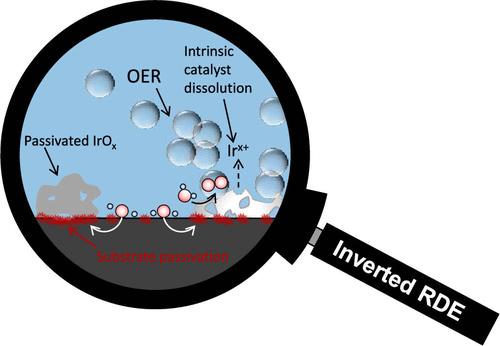Disentangling the Pitfalls of Rotating Disk Electrode-Based OER Stability Assessment: Bubble Blockage or Substrate Passivation?
IF 13.1
1区 化学
Q1 CHEMISTRY, PHYSICAL
引用次数: 0
Abstract
Oxygen evolution reaction (OER) catalyst stability metrics derived from aqueous model systems (AMSs) prove valuable only if they are transferable to technical membrane electrode assembly (MEA) settings. Currently, there is consensus that stability data derived from ubiquitous rotating disk electrode (RDE)-based investigations substantially overestimate material degradation mainly due to the nonideal inertness of catalyst-backing electrode materials as well as bubble shielding of the catalyst by evolved oxygen. Despite the independently developed understanding of these two processes, their interplay and relative impact on intrinsic and operational material stability have not yet been established. Herein, we employ an inverted RDE-based approach coupled with online gas chromatographic quantification that exploits buoyancy and anode hydrophilicity existing under operating acidic OER conditions and excludes the influence of bubble retention on the surface of the catalyst. This approach thus allows us to dissect the degradation process occurring during the RDE-based OER stability studies. We demonstrate that the stability discrepancy between galvanostatic nanoparticle (NP)-based RDE and MEA data does not originate from the accumulation of bubbles in the catalyst layer during water oxidation but from the utilization of corrosion-prone substrate materials in the AMS. Moreover, we provide mechanistic insights into the degradation process and devise experimental measures to mitigate or circumvent RDE-related limitations when the technique is to be applied to an OER catalyst stability assessment. These findings should facilitate the transferability between AMS and MEA approaches and promote further development of the latter.

解开基于旋转盘电极的 OER 稳定性评估的陷阱:气泡堵塞还是基底钝化?
从水性模型系统(AMS)中得出的氧进化反应(OER)催化剂稳定性指标,只有当它们可以转移到技术膜电极组件(MEA)设置中时,才会被证明是有价值的。目前,普遍认为基于旋转盘电极 (RDE) 的研究得出的稳定性数据大大高估了材料降解,这主要是由于催化剂支撑电极材料的非理想惰性以及挥发氧对催化剂的气泡屏蔽。尽管对这两个过程有了独立的认识,但它们之间的相互作用及其对材料内在和运行稳定性的相对影响尚未确定。在此,我们采用了一种基于倒置 RDE 的方法,并结合在线气相色谱定量,该方法利用了运行酸性 OER 条件下存在的浮力和阳极亲水性,并排除了催化剂表面气泡滞留的影响。因此,这种方法使我们能够剖析基于 RDE 的 OER 稳定性研究中发生的降解过程。我们证明,基于电流静态纳米粒子 (NP) 的 RDE 和 MEA 数据之间的稳定性差异并非源于水氧化过程中催化剂层中气泡的积累,而是源于在 AMS 中使用了易腐蚀的基底材料。此外,我们还提供了降解过程的机理见解,并设计了实验措施,以在将该技术应用于 OER 催化剂稳定性评估时,减轻或规避与 RDE 相关的限制。这些发现将促进 AMS 和 MEA 方法之间的可移植性,并推动后者的进一步发展。
本文章由计算机程序翻译,如有差异,请以英文原文为准。
求助全文
约1分钟内获得全文
求助全文
来源期刊

ACS Catalysis
CHEMISTRY, PHYSICAL-
CiteScore
20.80
自引率
6.20%
发文量
1253
审稿时长
1.5 months
期刊介绍:
ACS Catalysis is an esteemed journal that publishes original research in the fields of heterogeneous catalysis, molecular catalysis, and biocatalysis. It offers broad coverage across diverse areas such as life sciences, organometallics and synthesis, photochemistry and electrochemistry, drug discovery and synthesis, materials science, environmental protection, polymer discovery and synthesis, and energy and fuels.
The scope of the journal is to showcase innovative work in various aspects of catalysis. This includes new reactions and novel synthetic approaches utilizing known catalysts, the discovery or modification of new catalysts, elucidation of catalytic mechanisms through cutting-edge investigations, practical enhancements of existing processes, as well as conceptual advances in the field. Contributions to ACS Catalysis can encompass both experimental and theoretical research focused on catalytic molecules, macromolecules, and materials that exhibit catalytic turnover.
 求助内容:
求助内容: 应助结果提醒方式:
应助结果提醒方式:


